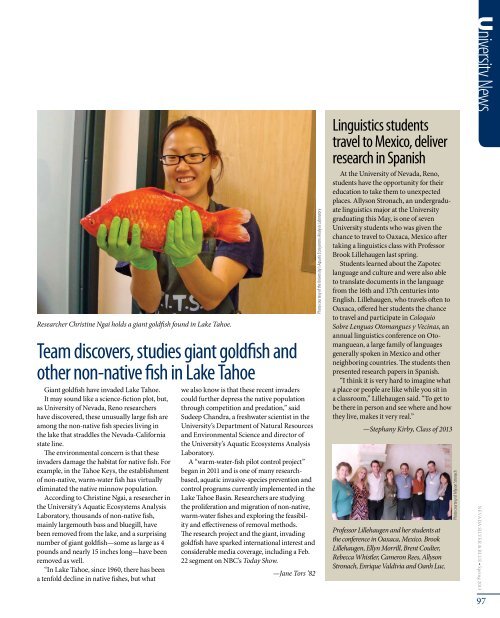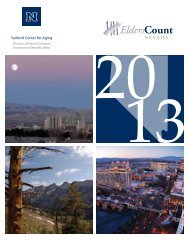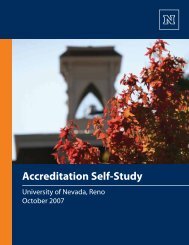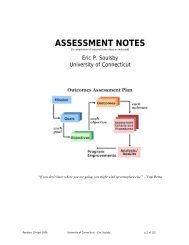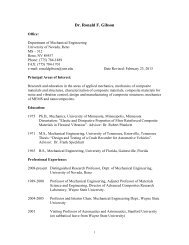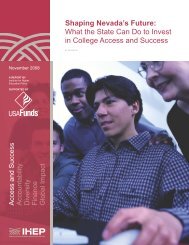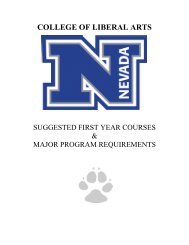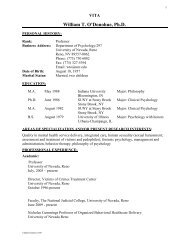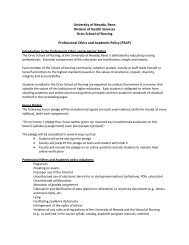NSB Spring 2013 - University of Nevada, Reno
NSB Spring 2013 - University of Nevada, Reno
NSB Spring 2013 - University of Nevada, Reno
You also want an ePaper? Increase the reach of your titles
YUMPU automatically turns print PDFs into web optimized ePapers that Google loves.
Researcher Christine Ngai holds a giant goldfish found in Lake Tahoe.<br />
Team discovers, studies giant goldfish and<br />
other non-native fish in Lake Tahoe<br />
Giant goldfish have invaded Lake Tahoe.<br />
It may sound like a science-fiction plot, but,<br />
as <strong>University</strong> <strong>of</strong> <strong>Nevada</strong>, <strong>Reno</strong> researchers<br />
have discovered, these unusually large fish are<br />
among the non-native fish species living in<br />
the lake that straddles the <strong>Nevada</strong>-California<br />
state line.<br />
The environmental concern is that these<br />
invaders damage the habitat for native fish. For<br />
example, in the Tahoe Keys, the establishment<br />
<strong>of</strong> non-native, warm-water fish has virtually<br />
eliminated the native minnow population.<br />
According to Christine Ngai, a researcher in<br />
the <strong>University</strong>’s Aquatic Ecosystems Analysis<br />
Laboratory, thousands <strong>of</strong> non-native fish,<br />
mainly largemouth bass and bluegill, have<br />
been removed from the lake, and a surprising<br />
number <strong>of</strong> giant goldfish—some as large as 4<br />
pounds and nearly 15 inches long—have been<br />
removed as well.<br />
“In Lake Tahoe, since 1960, there has been<br />
a tenfold decline in native fishes, but what<br />
we also know is that these recent invaders<br />
could further depress the native population<br />
through competition and predation,” said<br />
Sudeep Chandra, a freshwater scientist in the<br />
<strong>University</strong>’s Department <strong>of</strong> Natural Resources<br />
and Environmental Science and director <strong>of</strong><br />
the <strong>University</strong>’s Aquatic Ecosystems Analysis<br />
Laboratory.<br />
A “warm-water-fish pilot control project”<br />
began in 2011 and is one <strong>of</strong> many researchbased,<br />
aquatic invasive-species prevention and<br />
control programs currently implemented in the<br />
Lake Tahoe Basin. Researchers are studying<br />
the proliferation and migration <strong>of</strong> non-native,<br />
warm-water fishes and exploring the feasibility<br />
and effectiveness <strong>of</strong> removal methods.<br />
The research project and the giant, invading<br />
goldfish have sparked international interest and<br />
considerable media coverage, including a Feb.<br />
22 segment on NBC’s Today Show.<br />
—Jane Tors ’82<br />
Photo courtesy <strong>of</strong> the <strong>University</strong>’s Aquatic Ecosystems Analysis Laboratory<br />
Linguistics students<br />
travel to Mexico, deliver<br />
research in Spanish<br />
At the <strong>University</strong> <strong>of</strong> <strong>Nevada</strong>, <strong>Reno</strong>,<br />
students have the opportunity for their<br />
education to take them to unexpected<br />
places. Allyson Stronach, an undergraduate<br />
linguistics major at the <strong>University</strong><br />
graduating this May, is one <strong>of</strong> seven<br />
<strong>University</strong> students who was given the<br />
chance to travel to Oaxaca, Mexico after<br />
taking a linguistics class with Pr<strong>of</strong>essor<br />
Brook Lillehaugen last spring.<br />
Students learned about the Zapotec<br />
language and culture and were also able<br />
to translate documents in the language<br />
from the 16th and 17th centuries into<br />
English. Lillehaugen, who travels <strong>of</strong>ten to<br />
Oaxaca, <strong>of</strong>fered her students the chance<br />
to travel and participate in Coloquio<br />
Sobre Lenguas Otomangues y Vecinas, an<br />
annual linguistics conference on Otomanguean,<br />
a large family <strong>of</strong> languages<br />
generally spoken in Mexico and other<br />
neighboring countries. The students then<br />
presented research papers in Spanish.<br />
“I think it is very hard to imagine what<br />
a place or people are like while you sit in<br />
a classroom,” Lillehaugen said. “To get to<br />
be there in person and see where and how<br />
they live, makes it very real.”<br />
—Stephany Kirby, Class <strong>of</strong> <strong>2013</strong><br />
Pr<strong>of</strong>essor Lillehaugen and her students at<br />
the conference in Oaxaca, Mexico. Brook<br />
Lillehaugen, Ellyn Morrill, Brent Coulter,<br />
Rebecca Whistler, Cameron Rees, Allyson<br />
Stronach, Enrique Valdivia and Oanh Luc.<br />
Photo courtesy <strong>of</strong> Allyson Stronach<br />
<strong>University</strong> News<br />
NEVADA SILVER & BLUE • <strong>Spring</strong> <strong>2013</strong><br />
97


